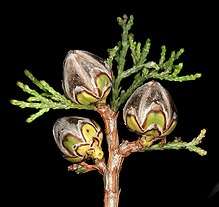Actinostrobus pyramidalis
Actinostrobus pyramidalis, commonly known as swamp cypress, Swan River cypress and King George's cypress pine,[3] is a species of coniferous tree in the Cupressaceae (cypress family). Like the other species in the genus Actinostrobus, it is endemic to southwestern Western Australia.
| Actinostrobus pyramidalis | |
|---|---|
 | |
| Scientific classification | |
| Kingdom: | Plantae |
| Clade: | Tracheophytes |
| Division: | Pinophyta |
| Class: | Pinopsida |
| Order: | Pinales |
| Family: | Cupressaceae |
| Genus: | Actinostrobus |
| Species: | A. pyramidalis |
| Binomial name | |
| Actinostrobus pyramidalis | |
| Synonyms[2] | |
| |
Swamp cypress is a shrub or small tree, reaching eight metres tall. The leaves are evergreen and scale-like, except on young seedlings, where they are needle-like. The leaves are arranged in six rows along the twigs, in alternating whorls of three. The male cones are small, 3–6 mm long, and are located at the tips of the twigs. The female cones start out similarly inconspicuous, but mature in 18–20 months to 1–2 cm with a rounded apex.
The cones open and release the seeds only upon drying. They tend to remain closed on the trees for many years, opening only if the branch, or the whole tree, dies. Bushfire kills swamp cypress, but it also causes a great many seeds to be released all at once, resulting in prolific regeneration. In one case, an isolated tree on Jeegarnyeejip Island was killed by fire, and the following winter there were 800 seedlings per square metre within a couple of metres of the original specimen, and about 150 per square metre ten metres away.
The species was first collected from Perth in September 1841 by Johann August Ludwig Preiss, and a description was published by Friedrich Anton Wilhelm Miquel in 1845 as Actinostrobus pyramidalis. A 2010 study of the genera Actinostrobus and Callitris found that all three species of Actinostrobus lay within the current concept of Callitris based on analysis of 42 morphological and anatomical characters, hence Actinostrobus pyramidalis was renamed Callitris pyramidalis.[4]
References
- Thomas, P. (2013). "Actinostrobus pyramidalis". IUCN Red List of Threatened Species. 2013: e.T34071A2842866. doi:10.2305/IUCN.UK.2013-1.RLTS.T34071A2842866.en.
- The Plant List: A Working List of All Plant Species, retrieved 8 December 2015
- Eckenwalder, J.E. 2009. Conifers of the World: The Complete Reference. Timber Press. p. 124
- Piggin, J., and Bruhl, J.J. (2010). Phylogeny reconstruction of Callitris Vent. (Cupressaceae) and its allies leads to inclusion of Actinostrobus within Callitris. Australian Systematic Botany 23: 69-93.
- "Actinostrobus pyramidalis". Flora of Australia Online. Department of the Environment and Heritage, Australian Government.
- "Actinostrobus pyramidalis". FloraBase. Western Australian Government Department of Parks and Wildlife.
- Farjon, A. (2005). Monograph of Cupressaceae and Sciadopitys. Royal Botanic Gardens, Kew. ISBN 1-84246-068-4.
- Powell, R. (1990). Leaf and Branch: Trees and Tall Shrubs of Perth. Perth, Western Australia: Department of Conservation and Land Management. ISBN 0-7309-3916-2.
External links
| Wikispecies has information related to Actinostrobus pyramidalis |
